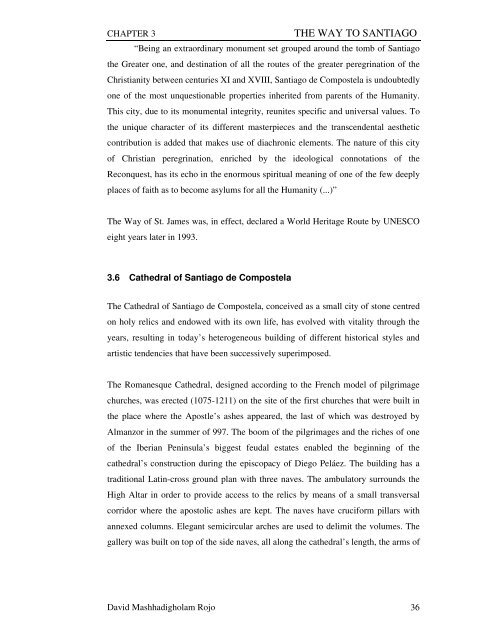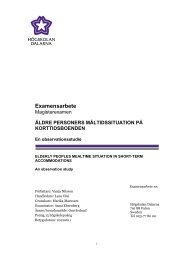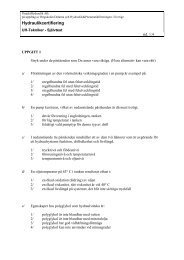Religious Tourism: The Way to Santiago
Religious Tourism: The Way to Santiago
Religious Tourism: The Way to Santiago
Create successful ePaper yourself
Turn your PDF publications into a flip-book with our unique Google optimized e-Paper software.
CHAPTER 3 THE WAY TO SANTIAGO<br />
“Being an extraordinary monument set grouped around the <strong>to</strong>mb of <strong>Santiago</strong><br />
the Greater one, and destination of all the routes of the greater peregrination of the<br />
Christianity between centuries XI and XVIII, <strong>Santiago</strong> de Compostela is undoubtedly<br />
one of the most unquestionable properties inherited from parents of the Humanity.<br />
This city, due <strong>to</strong> its monumental integrity, reunites specific and universal values. To<br />
the unique character of its different masterpieces and the transcendental aesthetic<br />
contribution is added that makes use of diachronic elements. <strong>The</strong> nature of this city<br />
of Christian peregrination, enriched by the ideological connotations of the<br />
Reconquest, has its echo in the enormous spiritual meaning of one of the few deeply<br />
places of faith as <strong>to</strong> become asylums for all the Humanity (...)”<br />
<strong>The</strong> <strong>Way</strong> of St. James was, in effect, declared a World Heritage Route by UNESCO<br />
eight years later in 1993.<br />
3.6 Cathedral of <strong>Santiago</strong> de Compostela<br />
<strong>The</strong> Cathedral of <strong>Santiago</strong> de Compostela, conceived as a small city of s<strong>to</strong>ne centred<br />
on holy relics and endowed with its own life, has evolved with vitality through the<br />
years, resulting in <strong>to</strong>day’s heterogeneous building of different his<strong>to</strong>rical styles and<br />
artistic tendencies that have been successively superimposed.<br />
<strong>The</strong> Romanesque Cathedral, designed according <strong>to</strong> the French model of pilgrimage<br />
churches, was erected (1075-1211) on the site of the first churches that were built in<br />
the place where the Apostle’s ashes appeared, the last of which was destroyed by<br />
Almanzor in the summer of 997. <strong>The</strong> boom of the pilgrimages and the riches of one<br />
of the Iberian Peninsula’s biggest feudal estates enabled the beginning of the<br />
cathedral’s construction during the episcopacy of Diego Peláez. <strong>The</strong> building has a<br />
traditional Latin-cross ground plan with three naves. <strong>The</strong> ambula<strong>to</strong>ry surrounds the<br />
High Altar in order <strong>to</strong> provide access <strong>to</strong> the relics by means of a small transversal<br />
corridor where the apos<strong>to</strong>lic ashes are kept. <strong>The</strong> naves have cruciform pillars with<br />
annexed columns. Elegant semicircular arches are used <strong>to</strong> delimit the volumes. <strong>The</strong><br />
gallery was built on <strong>to</strong>p of the side naves, all along the cathedral’s length, the arms of<br />
David Mashhadigholam Rojo 36
















